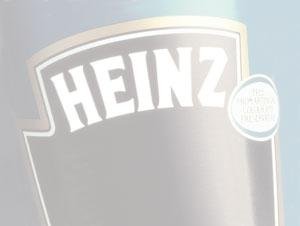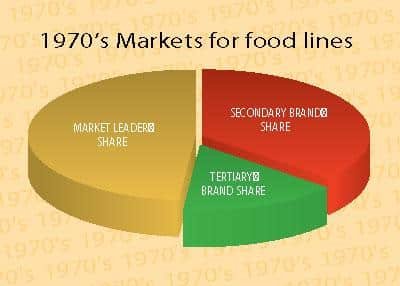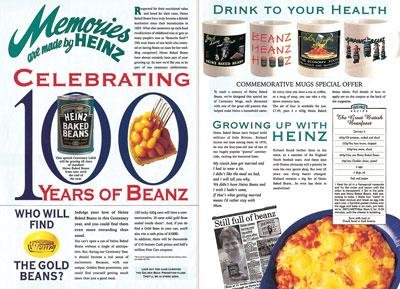
Organisations should learn from the past but not live in the past. This case study focuses on the way in which Heinz decided to alter the way in which it promoted its brands in order to be most effective in the market place in which it operates. In particular, it focuses on the way in which Heinz has set out to develop a close relationship with its millions of consumers through the development of a direct marketing database. This enables Heinz to communicate with individual consumers about its brand and its many product lines. The main benefit of this form of relationship marketing is that this enables Heinz to treat its customers as individuals. This helps the consumers to feel valued and that their custom is important.
As we move through the 90s, competitive businesses have developed new relationships with their customers. Direct marketing is a term used to include marketing activities which are designed to deal directly and personally with customers. In doing so, they are designed to induce a direct response. These activities are dependent upon the development of mailing lists. Heinz currently has a portfolio made up of a staggering 360 plus lines. The best known are:
- Heinz Tomato Soup
- Heinz Baked Beans
- Heinz Tomato Ketchup
The combined success of these lines has created the ‘brand effect’. Through this synergy, far more value is perceived than that of the individual products taken on their own. Given this synergistic effect, how much sense does it make to spend money advertising individual lines? Would it not make more sense to focus on the brand?
The changing marketplace

Today’s market place is quite different from that of the past. If someone who lived in the last decade of the nineteenth century were to visit a large, modern supermarket, they would be astonished at the variety of food products on sale. There is not only a great variety of products, but also a wide range of similar products. Additionally, in most towns there are several supermarkets to choose from.
Heinz is one of the most important competitors in many of these food lines. These range from baked beans, spaghetti, soups, macaroni, ravioli, pasta shapes, tomato ketchup, barbecue sauces, pickles, relishes, sandwich spreads, salad cream, mayonnaise, baby food, juices, tuna, frozen pizzas and many others. However, when we look at each of these lines, we find there is an increasingly complex structure. This complexity is a feature of the 90s and needs to be understood if we are to appreciate why Heinz has changed its marketing strategy.
In the 1970s the picture was different from today. Then, competition was mainly between brands. For example, in baked beans and soups, Heinz competed with Crosse and Blackwell and similar companies. Today, this is no longer the case. Now, in most categories of food items, the main competition for brands like Heinz Baked Beans is the retailer’s own brand. Food lines in the 1970s were characterised by a market leading brand competing against a secondary brand and then a tertiary brand. In a number of cases the manufacturers of secondary brands switched their production resources into own label and this has, of course, led to the increase in quality of own brands.
Brands and own labels
A development which is by no means new, but which has become very important in recent times, has been the development of budget or ‘B’ Brands. These are those products which are at the bottom end of the market e.g. ‘B’ Brand beans and ‘B’ Brand detergents. They are produced in large quantities, to different specifications and may be sold as loss leaders.
Own label brands are initiated and owned by retailers or wholesalers. The main feature of these brands is that it is the retailer who is identified with the brand and not the manufacturer. In recent times, supermarket own label products have moved up the value chain. In other words, many of these own label products are no longer second rate substitutes for branded products. Increasingly, they have started to compete in terms of quality and taste with the market leading brands.

What we then have today is a four tier category with ‘B’ Brands at the bottom, then secondary brands, followed by own label, with The Brand leading the market. At the same time, choice within each grocery category has mushroomed. We can see this effect if, for example, we examine the case of bottled sauces. Until a few years ago, the purchasing decision was limited to tomato ketchup or brown sauce. Today, consumer choice extends to Hot Ketchup, Texas Hot Ketchup, Curry Ketchup, Worcestershire Sauce Ketchup, Sonic the Hedgehog Ketchup, Curry Sauce, Chilli Sauce, several varieties of Barbecue Sauce and a whole host of other spicy sauces.
Marketing strategies

Heinz traditional approach for many years has been to engage in above-the-line advertising of its lines, mainly through television. However, 1994 saw a significant change in its approach. Heinz continues to use television advertising to support the umbrella ‘Heinz Brand’ i.e. the synergy of its 360 lines. However, it has significantly moved into direct marketing as a targeted approach to build stronger and more focused relationships with its customers. This is a new and innovative approach.
There are three main reasons why Heinz has decided to make this move.
- The proliferation of media channels and the associated fragmentation of consumer audiences, has called into question the effectiveness of the advertising for individual brands, especially when there are more than 360 in the portfolio. Many manufacturers are asking themselves; ‘Is there a better way of communicating individual brand messages to key consumers?’
- The development of sophisticated database systems for direct marketing. Today, marketing departments have available to them all the latest technology to obtain and retain information about their consumers, enabling them to communicate individually with these consumers.
- Increasing consumer sophistication means that consumers have become more selective from whom they buy. They are more likely to purchase those products which are most in-tune with their needs and wishes, i.e. with organisations who are prepared to listen to individual voices.
Leading the Field
Heinz believes that it is blazing a trail by introducing direct marketing to fast moving consumer goods (fmcg). Conventional wisdom has been turned on its head. Until recently, the view was that direct marketing might just have a role to play for high priced items like cars, financial services and home appliances, but could never be a cost-effective medium for fmcg. However, Heinz has a long history of diverting from accepted convention and breaking new ground. For example, in the nineteenth century, Heinz became the first company to pack sauces and condiments in clear glass jars so that consumers could see what they were getting for their money.
Relationship marketing

In her influential 1991 book ‘The Popcorn Report’, the American marketing guru Faith Popcorn charts the rise of consumer bonding or relationship marketing. The principles she identifies are particularly relevant to Heinz’ move into direct marketing – eg:
‘We do need to build relationships with our customers, to create a dialogue, expose them to our corporate values, establish a bond based on something more deep-seated than product quality, brand image or even simply meeting consumer needs.’
‘At Home’ has enabled Heinz to develop a genuine ongoing dialogue with consumers. The magazine is particularly useful for bringing information on new products to the attention of consumers in a relevant and motivating way.
Getting the approach right
The move into direct marketing by Heinz was not a ‘shot in the dark’. Rather it built on existing Heinz experience and understanding of markets. For example, Heinz had built up experience of database direct marketing to new mothers, through its ‘Baby at Home’ within their Infant Feeding business. The signs were very clear that this was a powerful way forward.
Today, information technology has given ‘intelligent organisations’ the potential to build a competitive edge through relationship marketing. The costs of investing in IT can be spread quickly over large outputs. For example, in 1996 it was 500 times cheaper to process an item of information than it was in 1976.
Developing a direct marketing approach

The primary direct marketing tool which Heinz has Follow-on-Milks, with coupons and samples. used, is its consumer magazine called Heinz ‘At Home’. This magazine is published several times a year and mailed to households from a database of over four million names. The names and addresses of these households were collected using an existing database of consumers who had responded to previous Heinz promotions and through other commercially available sources. This is a very important approach and demonstrates an exciting way of using information technology as a marketing tool to meet customer requirements. One of the key benefits of the programme, for both Heinz and consumers, is that the company is able to channel offers and promotions to the appropriate people. Tracking is an extremely important procedure.
Heinz monitors which households have redeemed which coupons in order to continue to offer consumers attractive, personalised offers on the products they want. Through this mechanism Heinz develops a clear picture of how individual consumers in their database are responding to the offers they are making. If the Jones family of Tennyson Avenue, Horsforth, is one of the four million households in the database, it is possible to check on which offers the family has taken up from the Heinz magazine. Heinz is then better placed to build an ongoing relationship with this family. This is a particularly powerful way of finding out how individual households are responding to new lines and promotional offers. Database marketing gives the marketer far more information than ever before.
Conclusion

Heinz has kept detailed records of the effectiveness of its move into direct marketing. The most informative indicator of the operations’ success, is the measurement of sales generated among recipients of Heinz ‘At Home’, compared with a control panel of consumers who do not. Clearly, the improvement in sales needs to be compared carefully with the cost of the operation.
Results so far have been encouraging. Many of Heinz’ core lines have recorded their highest brand share for several years following the Heinz ‘At Home’ activity. For example, Heinz soups market share rose to almost 60 per cent after the first mail out, from 54% before.
The first two editions of the magazine stimulated 1.5 million responses to offers and promotions from consumers and coupon redemption levels were extremely high. However, it is important to point out that the move is a strategic one and the effectiveness will need to be judged over the longer period.
Heinz’ marketing strategy today is based on the twin approach of generic advertising of the brand, coupled with personalised advertising of its lines to individual consumers. The whole of the Heinz portfolio is supported through television advertising. Through television advertising, Heinz is able to concentrate on the core relationships which the public recognises in the brand.
When it was developing its current advertising campaign, Heinz tested three different advertising concepts:
- ‘The family’ – Heinz brings the family back together;
- ‘Taste’ – Nothing tastes quite like Heinz, and
- ‘Memories of childhood’ – Heinz brings out the child in us all.
It was the last of these three propositions which struck the biggest consumer chord, as no brand is associated more with the golden days of childhood than Heinz. A more focused approach is then used, through direct marketing, to create individual relationships between customers and their favoured lines. For many consumers, Heinz is ‘the land of lost content’ and it is clear that this childlike property of the Heinz brand should sit at the heart of the umbrella campaign. Heinz has, therefore, focused on an advertising campaign which reinforces the idea that there is something about Heinz foods and the way they are eaten that is uniquely comforting; which enables everyone to recreate in a small way, the happy, carefree feelings of childhood; feelings that are lost with cheap substitutes.
Heinz has developed a modern approach to its marketing, using a strong overall campaign to remind people of the core values of the brand, coupled with a highly sophisticated database approach of direct marketing to individual customers.
